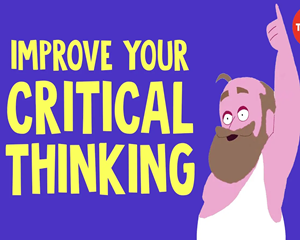(单词翻译:单击)
Socrates, one of the founding fathers of Western philosophical thought, was on trial.
苏格拉底,西方哲学奠基人之一,在接受审判。
Many Athenians believed he was a dangerous enemy of the state, accusing the philosopher of corrupting the youth and refusing to recognize their gods.
许多雅典人觉得他是危险人物、全民公敌,便指控这位哲学误导青年,亵渎神明。
However, Socrates wasn't feared for claiming to have all the answers, but rather, for asking too many questions.
然而人们并不是害怕苏格拉底声称自己全知,而是害怕他提出太多的问题。
While he loathed formal lectures, the philosopher frequently engaged friends and strangers in lengthy conversations about morality and society.
他厌恶形式化教育,经常召集朋友和陌生人一起深入探讨道德与社会。
These discussions weren't debates, nor would Socrates offer explicit advice.
他们只讨论,不辩论,苏格拉底也不明确给出自己的观点。
In fact, the philosopher often claimed to know nothing at all, responding to his partner's answers only with further questions.
事实上,这位哲学家时常称自己是无知者,面对他人的回答,他只会提出更深入的问题。
But through this process, Socrates probed their logic, revealing its flaws and helping both parties reach a more robust understanding.
借此,苏格拉底试探他们的逻辑思维,揭露其中的缺陷,使双方对此达成更深刻的理解。
These insightful questions made Socrates beloved by his followers.
苏格拉底见解独到,这使他深受追随者的喜爱。
Two of his students, Plato and Xenophon, were so inspired that they replicated their mentor's process in fictional dialogues.
他的两个学生,柏拉图和色诺芬深受启发,并以对话的形式把老师的名言记录了下来。
These invented exchanges provide perfect examples of what would come to be known as the Socratic Method.
这些创造性的对话构造了未来著名的苏格拉底法则。
In one of these fabricated dialogues, Socrates is conversing with a young man named Euthydemus, who is confident that he understands the nature of justice and injustice.
在其中一个虚构的对话中,苏格拉底与一个名为欧绪德谟的年轻人交谈,那名男子确信自己理解正义与不公的本质。
Socrates probes the student's values by asking him to label actions such as lying and theft as just or unjust.
为了探索学生的价值观,苏格拉底让他将一些行为进行分门别类,如撒谎和偷窃是否正义。
Euthydemus confidently categorizes them as injustices, but this only prompts another question: is it just for a general to deceive or pillage a hostile army?
欧绪德谟十分有把握地将这些行为归位不正义,但这引发了另一个思考:一名将军欺骗或抢掠敌军,这是正义的行为吗?
Euthydemus revises his assertion. He claims that these actions are just when done to enemies, and unjust when done to friends.
欧绪德谟补充了自己的论断。他称这些行为对敌人是正义的,于朋友而言,是不义。
But Socrates isn't finished. He asks the young man to consider a commander lying to his troops to boost their morale.
但苏格拉底不会轻易放弃。他接着问,如果一名指挥官为鼓舞士兵的士气而撒谎呢?
Before long, Euthydemus is despondent. It seems that every answer leads to further problems, and perhaps he's not quite sure what constitutes justice after all.
不久,欧绪德谟便感到沮丧。每一个回答似乎都能引起深刻的思考,或许他也不清楚正义到底是什么。

In employing this question-oriented approach, Socrates described himself as a midwife, whose inquiries assist others in giving birth to their ideas.
在运用这一问答法时,苏格拉底觉得自己像是一名助产士,通过质疑,帮助他人诞生自己的想法。
His method of questioning draws out an individual's unexamined assumptions, and then challenges those biases.
他先是提出未经考察的假设,再挑战那些偏见。
It doesn't always provide definitive answers, but the method helps clarify the questions and eliminate contradictory or circular logic.
使用这种方法或许不能提供确切的答案,但这能更好地阐明问题,解决矛盾,打破逻辑循环。
And by following a line of inquiry where it logically leads, both the question asker and answerer can end up in unexpected places.
通过一系列富有逻辑的质问,问题提出者和回答者都会有意想不到的收获。
This technique isn't limited by the conversation's content, making it incredibly useful in numerous fields.
这一方法不受对话内容的限制,因此可以在多个领域使用。
During the Renaissance, the method was used to teach clinical medicine.
文艺复兴时期,该方法用于临床医学教学中。
Students proposed their rationale for different diagnoses, while a doctor questioned their assumptions and moderated discussion.
根据不同诊断结论,学生给出自己的诊断原理,而一名医生对他们的假设提出疑问,进而主导了讨论。
In this model, the method could even produce conclusive results.
在这种情况下,通过问答法,甚至可以得出一个明确的结论。
This same approach was later used in other sciences, such as astronomy, botany, and mathematics.
同一方法后来也运用在其他学科中,如天文学、植物学和数学。
Following the Protestant Reformation, it was adapted to tackle abstract questions of faith.
在宗教改革之后,该方法用于解决抽象的信仰问题。
In the 19th century, the method became an essential part of American legal education.
在19世纪,此方法成为美国法律教育的重要组成部分。
Professors explored students' understanding of judicial reasoning by challenging them with unforeseen hypothetical situations.
教授们假设不可预知的案例,以此检验学生对于司法推理的理解。
This approach is still used today by the Supreme Court to imagine the unintended impacts of passing a law.
今天,最高法院仍然使用这种方法来预测新法律可能带来的影响。
The Socratic Method can be adapted to teach almost any topic that relies on critical reasoning, but its success depends on the teacher employing it.
苏格拉底法几乎适用于各种需要批判性思维的教学主题,但其效果取决于教师如何使用这一方法。
An effective Socratic educator must be well versed in their subject.
若想通过苏格拉底法取得成效,该教师必须精通自己的学科。
Rather than bullying their students or showing off their superior intellect, they should be modest, genuinely curious, and affirming of every contribution.
他们不应该欺负学生或是炫耀自己的聪明才智,而应该保持谦虚,真诚地好奇,肯定每一项贡献。
In this regard, Socrates himself may not have been the most subtle Socratic teacher.
在这方面,苏格拉底自己可能并没有察觉到自己创建了这一方法。
Historians believe he was deeply critical of Athens' particular brand of democracy, and known to pass those concerns onto his followers.
历史学家认为他对雅典特有的民主政治持猛烈的批评意见,并将其担忧传递给了他的追随者。
These subversive beliefs were distorted in public forums and thought to have inspired two of his pupils to treasonous ends.
这些颠覆性的信仰在公民大会上受到曲解,导致他的两个学生犯下叛国罪。
It was likely for these ideas Socrates was brought to trial, and eventually, sentenced to death.
很可能是因为这些想法,苏格拉底受到审判,最终判以死刑。
But even on his deathbed, artists depict a serene philosopher -- ever curious to explore the ultimate question.
但即使在临终之际,艺术家们也描绘了一位面容安详的哲学家,他总是好奇地探索终极问题。


